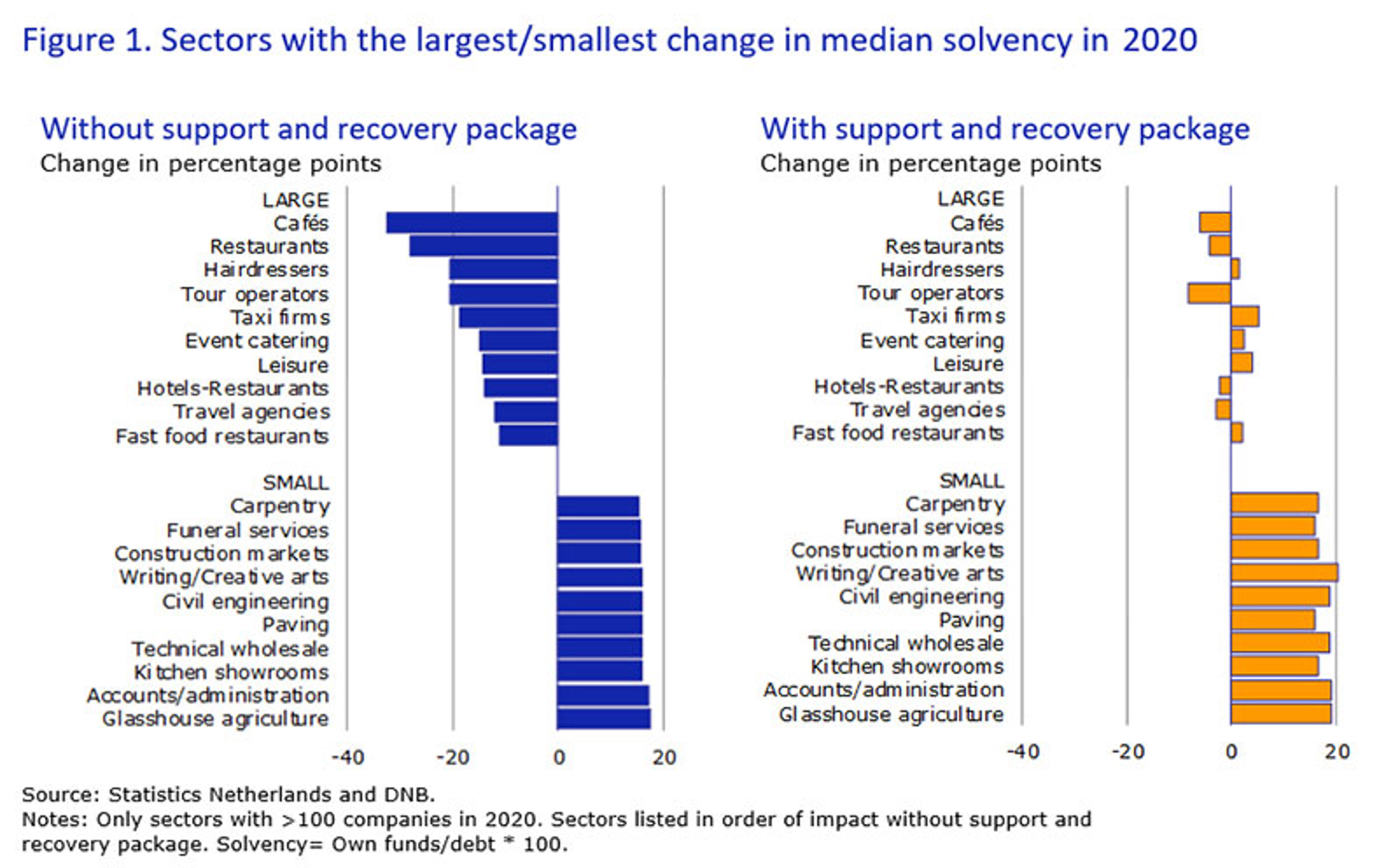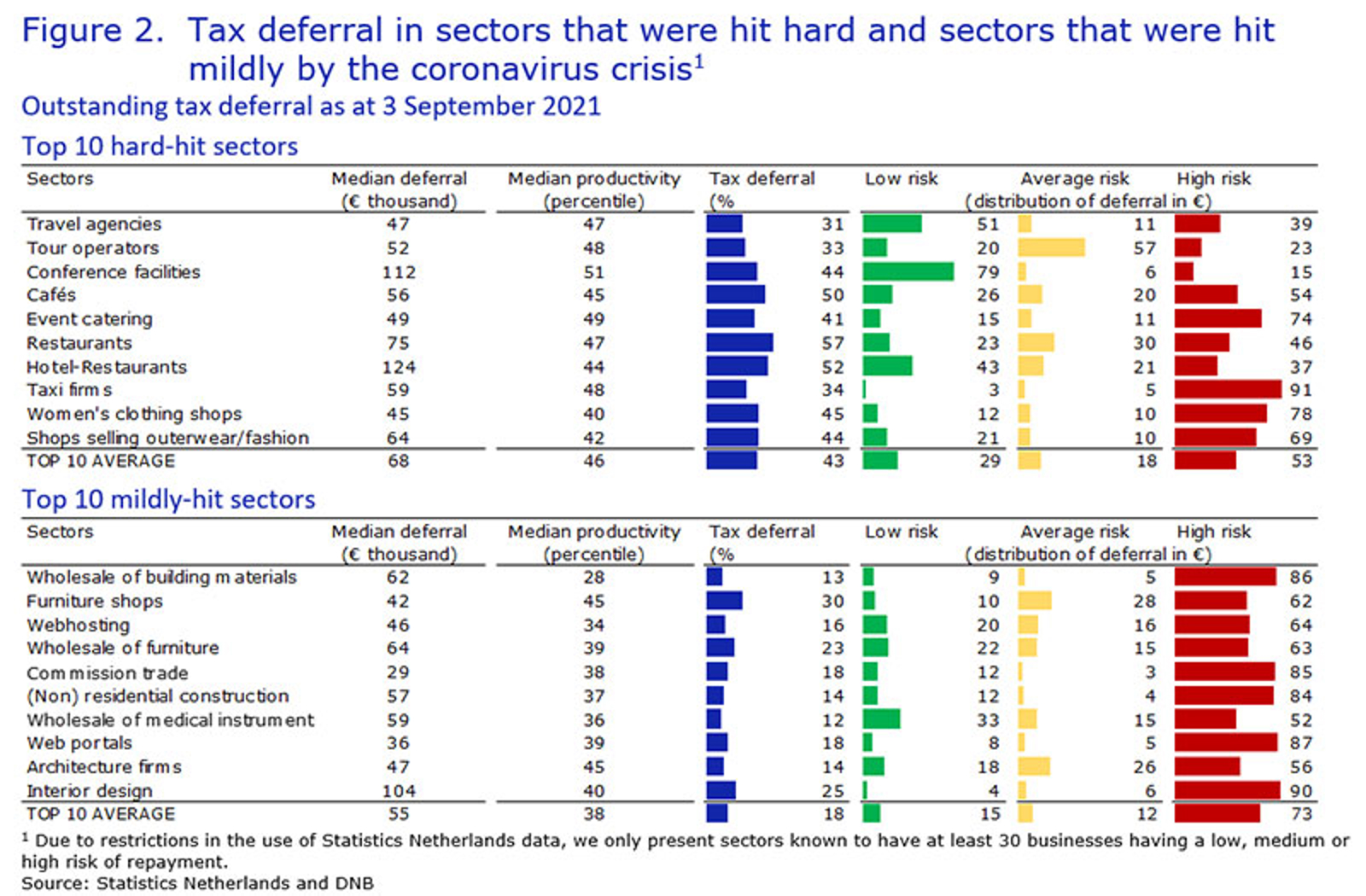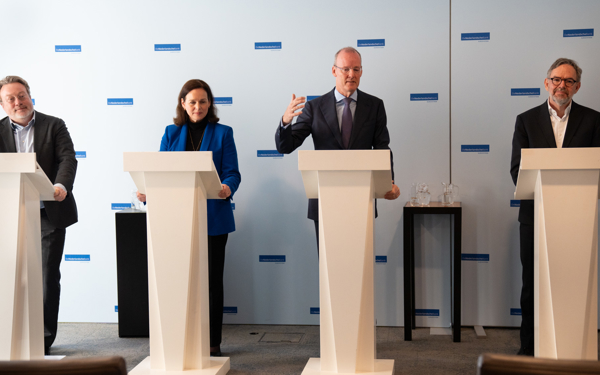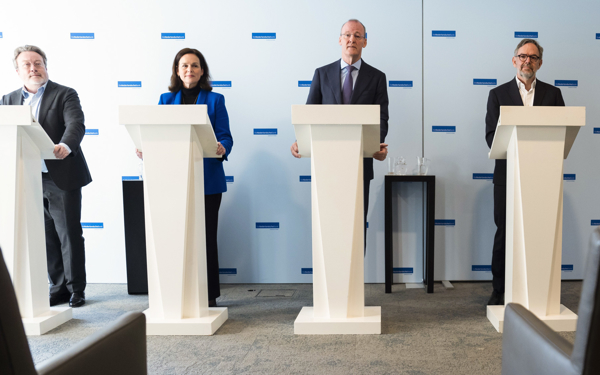Turnaround in the economy
According to the DNB business cycle indicator, the low point of the economic cycle has been reached, after which economic growth will pick up gradually and at a moderate pace this year.
Read more Turnaround in the economyYou are using an outdated browser. DNB.nl works best with:
Receive our latest news directly in your mailbox?
Register for our DNB News Service.
Published: 30 March 2022

© Shutterstock
During the coronavirus (COVID-19) crisis, the Dutch government supported trade and industry with a comprehensive package of measures. In a new analyse DNB concludes that in the first year of the coronavirus crisis the support measures were successful in compensating for turnover losses in the sectors that had been hit hardest. At the same time, the analysis shows that part of the support also reached sectors that were less affected by the coronavirus crisis. Generic support policies reduce the incentive for businesses to adapt to the new situation. That is why it is important to move away from generic support from now on.
In March 2020, the government intervened quickly and decisively to absorb turnover loss caused by the impact of the social distancing measures during the lockdown. The support measures turned out to be very successful. They kept the number of company failures and unemployment low, allowing the economy to rebound quickly during periods without social distancing measures. Yet, the support measures have cost the government a lot of money. Measures intended to support businesses facing turnover losses – such as the wage cost subsidies (NOW) and the contribution towards fixed costs (TVL) – cost a total of about €40 billion, and at present businesses still have an aggregate outstanding debt to the Tax and Customs Administration of roughly €20 billion. There is also the possibility that the support measures have allowed many underperforming businesses to stay afloat, whereas in an economy with 'normal' business dynamics these businesses would have gone bankrupt.
DNB's analysis shows that the support and recovery package in 2020 was successful in mitigating the shock to the financial position of businesses resulting from the coronavirus outbreak. The support measures slowed, but not fully prevented the depletion of liquidity, the increase in debt and the deterioration of solvency in the sectors that were hit hard by the coronavirus crisis. Figure 1 shows how the median solvency ratio developed in 2020 (right) and how it would have developed without the support and recovery package (left) in the top 10 sectors for which the support and recovery package had the biggest or the smallest impact. The graphs show that the support and recovery package has had a strong mitigating effect on the deterioration of solvency positions in the sectors that were hit hardest by the crisis, while their impact in the sectors that were far less affected by the coronavirus crisis is much smaller.

The micro data we used also show that the uptake of NOW and TVL from the second quarter of 2020 until the second quarter of 2021 was concentrated with businesses suffering a relatively large turnover loss compared to previous years. Both high-performing and underperforming businesses have benefited from NOW and TVL. The fear that the support would mainly go to underperforming businesses therefore appears to be unfounded. At the same time, its use is not limited to businesses in sectors that have been hit hard by the coronavirus crisis. Businesses with heavy turnover losses in less affected sectors have also benefited from the support. After all, the schemes were designed (depending on the period) in such a way that all businesses with high turnover losses could apply for the scheme, regardless of their sector. As a result, part of the support may have been distributed ineffectively.
Also in the case of the coronavirus-related tax deferral, we see that businesses in sectors that were hit relatively hard by the coronavirus crisis make use of the scheme more frequently and for higher amounts on average. Figure 2 shows the distribution of the outstanding tax deferral at 3 September 2021 for the ten hardest hit sectors and the ten sectors that were least affected by the coronavirus crisis. While an average of 43% of businesses from the hardest hit sectors have applied for tax deferral, this is only 18% on average for those sectors that were least affected by the crisis. The median amount of outstanding coronavirus-related tax deferrals is almost 25% higher in the hard-hit sectors. However, a large part of the tax deferral also goes to businesses that have been hit relatively mildly by the coronavirus crisis and, in contrast to the measures from the support package, relatively often to underperforming businesses. The difference between the tax deferral on the one hand and NOW and TVL on the other suggests that a turnover threshold, which was not used for the tax deferral, may be an important contribution to targeting the measure.
A relatively large part of the tax debt is owed by businesses whose past profitability may not be sufficient to repay the debt without any difficulties. In hard-hit sectors, 53% of businesses that benefited from a tax deferral are exposed to a high risk of payment problems, while this is as high as 73% for sectors that were affected only mildly by the coronavirus crisis. A high risk means that these businesses must use more than half of their pre-pandemic gross monthly profit for a period of five years in order to repay the coronavirus-related tax debt. These figures indicate that the scheme mainly benefits the less profitable businesses in the sectors that have only mildly been affected by the coronavirus crisis and thus potentially distorts healthy economic dynamics. However, by no means have all businesses made use of the tax deferral option. The businesses that are at high risk of running into tax debt repayment problems make up 7.5% of the total number of businesses in our data. Viable businesses with a high outstanding debt or tax debt may need debt restructuring for the healthy continuation of business activities. We therefore welcome the Tax and Customs Administration's announcement that it will be more lenient in amicable settlements and the Act on the Confirmation of Out-of-Court Restructuring Plans (Wet homologatie onderhands akkoord - WHOA)as of August 2022. In order to cushion a possible increase in the number of debt rescheduling agreements, it is important that the government identifies potential bottlenecks and resolves them if necessary. These bottlenecks can occur, for example, in the judiciary, in debt restructuring practice, in debt counselling and in the Tax and Customs Administration.

At the beginning of the coronavirus crisis, the support measures’ objectives were to cushion the economic shock by compensating those businesses that unexpectedly suffered high turnover losses and to preserve jobs. Our analysis shows the measures to have been successful in this respect. At the same time, the disadvantages of the generic support measures increase with time. Firstly, especially in the case of tax deferral, it appears that a substantial group of underperforming businesses and those in sectors that were only mildly affected by the coronavirus crisis also benefited from the scheme, suggesting that the support was not always equally effective. Secondly, freezing the economy is becoming increasingly expensive. Now that we have to learn to live with the coronavirus pandemic, businesses will need to adapt to the new situation. The support measures actually reduce the incentive for businesses to do so. That is why, in an unfavourable scenario in which large parts of the economy are again forced to shut down for a long period of time, it is important to target the support more effectively. This can first of all be done by focusing the support more on those sectors directly affected by compulsory business shutdowns. In addition, a turnover threshold may increase the effectiveness of the measures.
DNBAnalyse - De invloed van het corona steun- en herstelpakket op het Nederlandse bedrijfsleven

According to the DNB business cycle indicator, the low point of the economic cycle has been reached, after which economic growth will pick up gradually and at a moderate pace this year.
Read more Turnaround in the economy
In the fourth quarter of 2023, foreign multinationals transferred over €300 billion in conduit activities from the Netherlands abroad. These relocations indicate adjustments in business structures, and may be due to the introduction this year of a minimum tax for these international companies.
Read more Conduit activities in the Netherlands declined in fourth quarter of 2023
The Dutch economy is strong and resilient, but not everyone in the Netherlands experiences it that way. Many people are struggling financially or have concerns about their future. The Netherlands should therefore strive for a highly developed and finely tuned economy that works better for everyone.
Read more Towards an economy that works better for everyone
“We see that while the Dutch economy is doing quite well, it is not working well enough for some groups in society.” Klaas Knot said this at the presentation of DNB’s 2023 Annual Report.
Read more Introductory remarks upon the presentation of the 2023 annual reportWe use cookies to optimise the user-friendliness of our website.
Read more about the cookies we use and the data they collect in our cookie notice.